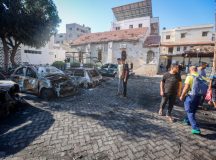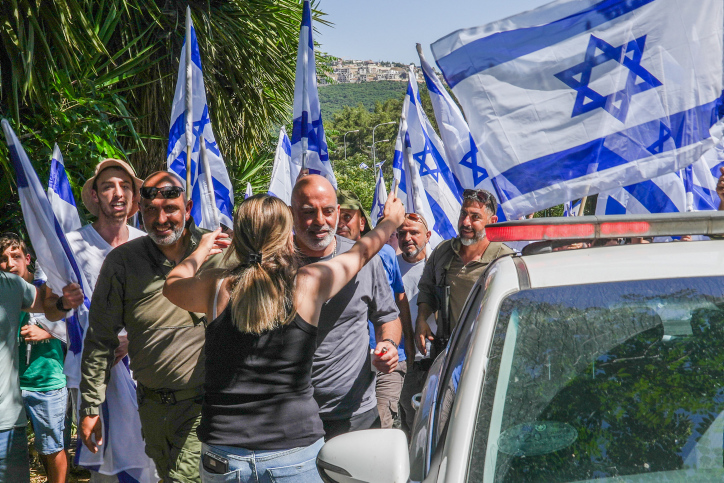Social Media platforms like Telegram have become integral to Hamas’s communications and information warfare. OSINT analyst Tal Hagin charts the development of this phenomenon, arguing that ‘It is essential for… governments to recognise the significance of this aspect of warfare, as it is likely to become a central tactic for these militant groups and even individual actors in the near future. The ability to undermine the morale of a society should be a national security concern and not be taken lightly.’
Throughout history, bolstering morale during times of conflict has stood as a cornerstone for motivating soldiers and garnering civilian support. Once the domain of well-equipped nations boasting specialised psychological warfare units such as USACAPOC, Russia’s Unit 54777, and the UK’s 77th Brigade, this landscape has now dramatically shifted. In today’s interconnected world, individuals armed with nothing more than an internet connection, a smartphone, and access to encrypted platforms like Telegram can effectively sow discord within enemy populations from the comfort of their own homes.
Palestinian militant factions have adeptly harnessed this capability, exercising significant control over the narrative amidst the ongoing conflict between Israel and Gaza: this represents a stark reminder that the ability to influence enemy morale is as indispensable as military might, sounding a crucial alarm for national security strategists worldwide.
Telegram, established in 2013 as an encrypted instant messenger app, quickly gained a reputation as a platform for various activities, including criminal transactions. Telegram stood out for its dedication to user anonymity, and lack of content filters permitting the resurgence of graphic and violent content banned on mainstream platforms like Instagram and Facebook, all while remaining accessible to everyone. These channels became a hub for uncensored content, showcasing everything from gang-related shootings to brutal acts by rebel groups, including beheadings and torture.
Starting around 2015 and 2016, the circulation of frontline videos created by ISIS fighters and supporters on Telegram during the war against ISIS offered ordinary civilians an unprecedented opportunity to witness ongoing conflicts in real time, bypassing traditional media filters. This trend persisted during the Donbas War (2014-2022) between Ukrainian forces and separatists and the Russian military, but reached its peak with Russia’s invasion of Ukraine on 24 February 2022. Ordinary people could now observe the invasion and ensuing war unfold, uncensored, as it happened.
Governments and organisations seized the opportunity to leverage these images and videos for various purposes. They used them to illustrate Russian and Ukrainian losses or victories, highlight alleged atrocities committed by their adversaries, and boost morale among their populations. In this new era of information dissemination, raw visuals of burnt-out vehicles and casualties were weaponised to shape narratives and galvanise support.
On the other side of the world, Palestinian militant groups began to realise the true potential of platforms like Telegram, particularly during the May 2021 crisis between Israel and Hamas and the ensuing riots in mixed Jewish-Arab towns within sovereign Israel. This period also witnessed the emergence of numerous Palestinian militant groups in the West Bank, prominent among them the Jenin Battalion, all seeking to secure an efficient communication method with their supporters and members, shielded from IDF intelligence surveillance. Telegram, due to its simplicity and encryption, quickly emerged as the ideal tool to use.
Out of this dynamic, two distinct streams of Palestinian militancy communication surfaced. The first, in Arabic, centred around the actions of specific groups. The second, in English, aimed to disseminate their messages to a broader, predominantly Western audience. These Arabic channels also served as hubs for communication among the groups, where regular individuals shared photos and videos documenting IDF activities. This collective effort posed significant challenges for the IDF’s operations in the West Bank, as they were constantly under scrutiny and surveillance by these groups, effectively creating an informal intelligence network that attempted to rival Israel’s.
Conversely, the English-language channels, utilised by militant groups across the West Bank, Gaza, and Southern Lebanon, adopted a unified strategy: showcasing their operations against both civilian and military targets in Israel to not only their adversaries but also to a global audience. This strategy aimed to seize control of the narrative from Israel, preventing the censorship or downplaying of their capabilities. As a result, images and videos began to flood these channels, depicting militants striking Israeli settlements in the West Bank, engaging soldiers and targeting civilians in cities like Tel Aviv, and launching rocket attacks on IDF forces along the Gaza border. This visual representation not only emboldened these groups but also conveyed to Israelis that they were vulnerable, constantly under surveillance, and within striking distance. The IDF’s ability to control information about attacks on its populace was undermined, and the full extent of the violence was laid bare for the world to see.
Another useful component of Telegram is the ability to download videos and photos from the channels without the need for third-party apps. This feature made it incredibly easy to share content from these channels with mainstream sites. While many social media platforms tried to restrict supporters of these channels from sharing graphic content, others, like X (formerly Twitter), having a very unstable moderation process became a hub for such content to be uploaded. This facilitated a raw stream of unfiltered videos and images depicting the activities of militant groups. Moreover, it made it easy to trace back the imagery to the Telegram channel, creating a support loop of new followers; both for the Telegram channel and the online news channel spreading their content.
This tactic proved remarkably effective, as evidenced by the shift in Israeli public awareness. Previously reliant on official notices from government sources or IDF spokespersons to learn about soldiers’ or citizens’ deaths, the public could now witness firsthand the failures in their country’s duty to safeguard them. This direct access eliminated the government’s and IDF’s ability to downplay incidents to avoid criticism. For instance, consider the case of Border Police officer Barel Shmueli, critically wounded in a shooting on the Gaza border on 21 August 2021, and succumbing to his injuries on 30 August. Shortly after his death, a video surfaced, filmed by Palestinians, depicting the gunman approaching the border wall and shooting Barel point-blank. This scene underscored to many Israelis the vulnerability of their troops, prompting calls for a change in the IDF’s policy on the Gaza border fence. The potential impact of such videos became apparent, offering civilians a new perspective on the realities of being targeted by enemy forces. This awareness was not lost on Hamas and other Palestinian militant groups, as demonstrated by the events of October 7th.
7 October
At 6:30 in the morning on 7 October, the military wing of Hamas, Al-Qassam, initiated an assault on Southern Israel under the banner of ‘Operation: Al-Aqsa Flood.’ This attack also saw the participation of several other Palestinian militant groups. Later during the assault, hundreds of Gazan civilians also crossed the border. The targets included several military bases, towns, communities and a music festival resulting in the loss of approximately 1,200 lives, with roughly 70 per cent of the casualties being civilians. Additionally, over 240 civilians and soldiers were taken captive back to Gaza. As well as their arsenal of rockets, mortars, IEDs, drones, light weaponry, and RPGs; all utilised to overpower the IDF’s security apparatus and infiltrate IDF bases and towns, many of these militants were armed with an additional, perhaps equally significant piece of equipment: their smartphones and Go-Pros.
As the day progressed, these Telegram channels became inundated with raw images and videos of the attack, captured on these very devices. These included footage of multiple IDF soldiers being executed at close range, a Thai worker being bludgeoned to death by a shovel to their head and neck, a family being held at gunpoint on a Facebook livestream, and videos of individuals being taken back into Gaza as captives, some while begging or screaming. These graphic materials served as the primary source of information not only for the global audience but also for Israelis themselves.
In the absence of Israeli media on the ground during the initial hours, Palestinian militant groups assumed control of the narrative, emerging as the primary source of information for their adversaries, the Israeli public. Many families did not receive updates on the events through government representatives or filtered reports from experts. Instead, they learned about the fate of their loved ones through the raw and gruesome photos and videos shared by Palestinian militant groups and their supporters. With their country seemingly invaded and no visible governmental control, the Israeli public experienced a sense of powerlessness and uncertainty. This direct exposure to the brutality of the situation inflicted widespread trauma throughout the nation.
Following the 7 October attacks, Palestinian militant groups persistently employed psychological warfare tactics against Israel. They circulated videos of captives held by various groups and disseminated numerous unsourced claims, and out-of-context photos and videos to further diminish Israels attempts at controlling the narrative in the aftermath of October 7th. In response, Israeli journalists and government representatives rushed to gather documentation of the attack, leading to the publication of several high-profile claims. However, some of these claims, such as the infamous ‘40 beheaded babies’ story, were later retracted due to misquoting or the inability to verify them by third parties. This undermined Israel’s credibility as it struggled to keep pace with the combative psychological warfare tactics employed by these groups, hindering efforts to garner international support and fostering greater distrust within Israeli society. This also impacted the IDF, prompting a rush to release numerous graphics claiming evidence of Palestinian militant activity near or in civilian areas. However, much of this evidence couldn’t be verified by any independent third party, undermining its effect on public opinion.
Furthermore, it came to light that while officially utilising Telegram for activity updates akin to its social media platforms, an unofficial IDF channel surfaced, uncovered by Haaretz,. This channel, overseen by an IDF psychological warfare unit, disseminated graphic images and videos of injured or deceased Palestinian militants and civilians, alongside captions that dehumanised them. According to Maj. Gen. Oded Basyuk’s internal investigation, this unit operated without authorisation, and the initiation of the page was done without approval or authority from leadership (the channel is still active). Whether directed to emulate the methods of Palestinian militant groups or acting independently, it underscored the alarming effectiveness of this tactic against Israeli society, compelling imitation.
Simultaneously, the pressure on the State of Israel to legitimise itself and garner support intensified with the deployment of numerous strikes on Gaza targets. The IDF’s objective was clear: to ‘Remove Hamas and its capabilities from power.’ This escalation resulted in civilian casualties and prompted constant scrutiny and mutual blame between Palestinian telegram channels and IDF officials. The explosion at the Al-Ahli hospital courtyard on the 17 of October, 2023, further fuelled this blame game. Initial reports claimed around 500 people were killed in an alleged IDF airstrike, but the IDF promptly denied involvement, presenting evidence to shift blame onto Palestinian militants. Conflicting narratives and a high reported death toll prompted extensive scrutiny from analysts and media outlets.
Despite thorough investigation efforts by major news sources and analysts, including my own comprehensive analysis of the event, definitive conclusions remained elusive. Most investigations conducted have concluded that the probable source of the blast was a misfired rocket by a Palestinian militant group. Additionally, there was a notable absence of third-party investigators who could verify claims on the ground. The proliferation of false testimonies, photos, and videos further compounded the challenge of independently verifying claims online. These factors highlight the difficulties faced by individuals caught between the information warfare of Palestinian militant groups and Israel. Even those seeking impartiality were not immune to the spread of misinformation, underscoring the complexities of the conflict.
As the conflict between IDF forces and Palestinian militant groups in Gaza persists, the psychological warfare waged by these groups against the Israeli public inevitably affects onlookers as well. It is essential for other governments to recognise the significance of this aspect of warfare, as it is likely to become a central tactic for these militant groups and even individual actors in the near future. The ability to undermine the morale of a society should be a national security concern and not be taken lightly.




































